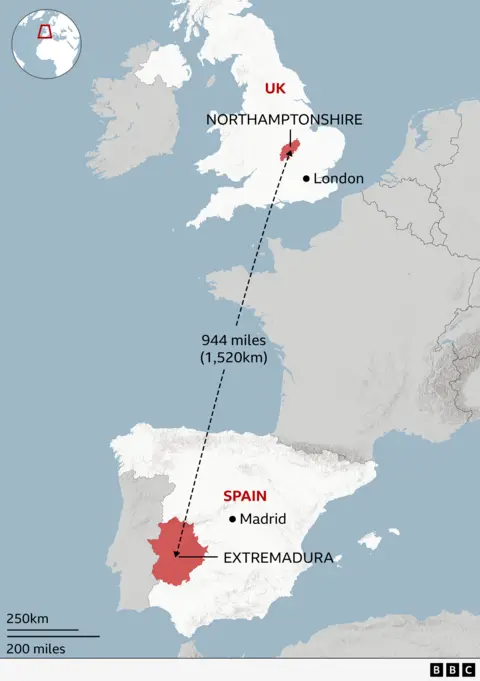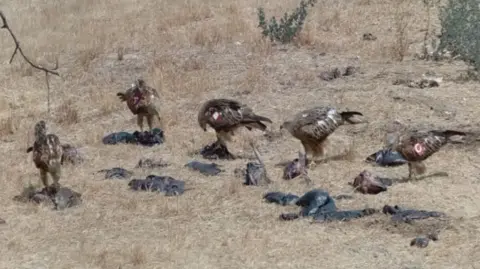Katharine Da CostaSouth of England
A British red kite emerges from an aviary in the remote hills of western Spain and takes flight. At six months old, this is its first taste of freedom.
Without a sound, it soars high in the sky above scrubland and within seconds disappears from view into a wooded valley in the distance.
It is the latest release in a conservation story that has come full circle.
Nearly four decades ago, the birds were extinct in England and Scotland with just a few pairs left in Wales.
In the late 1980s and early 1990s, red kite chicks from Spain and Sweden were released in the Chilterns on the Oxfordshire-Buckinghamshire border.
It proved so successful that the species is now thriving across the UK, with estimates of more than 6,000 mating pairs or about 15% of the world’s population.
Dr Ian Evans, from Natural England, was one of the early pioneers.
He said: “There were a lot of unknowns. The first lot we released, we thought they might just die or they might just move away.
“In 1991, we had our first breeding pairs and that was really an eye-opener because we thought ‘well, this can be successful’.
“That was the springboard for establishing other release sites in England and Scotland.”
 Ian Evans
Ian EvansBritish-born red kite chicks have now been taken to south west Spain as part of a four-year project to revive the population there from the brink of extinction.
The region has fewer than 50 mating pairs due to predators like the eagle owl and human factors such as illegal poisoning and electrocution.
In 2022, conservationists were granted special licenses from Natural England to collect red kite chicks, mostly from Northamptonshire, and send them over to the Extremadura region of Spain.
More than 120 chicks have been collected, with about 30 exported each year.
 Simon Dudhill
Simon DudhillAbout the red kite
- It is one of Britain’s largest birds of prey, known for its reddish-brown body, long wings, forked tail and distinctive “mewing” calls
- Once considered a threat to game birds and domestic animals like cats and dogs, the red kite was hunted close to extinction in the UK and at one point there were just a few breeding pairs in central Wales
- Red kites are largely scavengers, feeding on carrion and small prey such as rabbits
- The birds breed exclusively in Europe and are endangered due to illegal persecution through shooting, poisoning and trapping

The chicks are flown to Madrid and then transported 240 miles (385km) south to a wildlife hospital in Villafranca de los Barros, run by Accion por el Mundo Salvaje (AMUS).
When I arrive, the small team, led by ornithologist and project manager Alfonso Godino, are hard at work.
Each chick has to be weighed, measured and tagged before being fitted with a GPS backpack which allows experts to track them.
The birds look lifeless as they are manoeuvred into position. Mr Godino tells me they play dead when they feel under threat.
Asked whether the tagging is painful, he says it is a minor discomfort, like having your ears pierced.
Alfonso says the juveniles soon get used to the large tags, which are needed so they can be observed from the ground.
The birds are then moved to holding aviaries near the Portuguese border for two weeks to acclimatise to their new surroundings.
The release site is quiet and remote. There is a strong stench of rotting flesh coming from a sheep’s carcass that has been left to entice red kites to feed here.
As the gate is removed, I half expect the chicks to rush out but, but apart from a few flutters inside the aviary, nothing happens.
It takes several hours, as though they are building up courage, before one by one they leave the safety of the aviary behind and fly off into the wild.
‘Bittersweet moment’
“Now is the exciting moment when they are in the wild, they can learn to search for food, to avoid predators, to interact with other species in the area… thanks to the GPS we are going to closely monitor these birds we have released,” Alfonso tells me.
But this is a nerve-racking time for AMUS field technician Sofia Marrero.
“The mortality for raptors in general is really high during the first years of their life,” she says. “So now it’s a little bit hard because you already know that some of them may not get to sexual maturity, so it’s a bittersweet moment.”
In fact, only about a quarter of the red kites released during the project have survived.
The biggest threat is from predators and natural causes.
In 2023, eagle owls were responsible for killing half of the project’s newly released red kite chicks.
In response, the team at AMUS adapted how and when the chicks are released to increase their chances of survival.
 Sebastien Comps, AMUS
Sebastien Comps, AMUSA lot of work has also been done to adapt thousands of kilometres of power cables to reduce the risk of electrocution.
But the biggest human risk to birds of prey is from illegal poisoning.
Between 2020-2024, 3,060 red kites were tagged and fitted with GPS as part of the Life EuroKite project, spanning 40 project areas in 12 countries.
By September 2024, 1,377 tagged red kites had died – 622 from natural causes, including predation, while 195 died from poisoning and 54 from illegal shooting.
Experts say the figures represent just the “tip of the iceberg” in terms of illegal persecution.
In the UK, the RSPB is working with European partners to provide advice on how to investigate cases of poisoning.
A report by the charity last year revealed at least 1,344 birds of prey had been killed in the UK between 2009 and 2023.
“Raptor persecution is directly linked to game estates so in the lowlands pheasant and partridge and in the uplands grouse,” Mark Thomas, head of investigations at RSPB says.
“All the statistics prove that… two thirds of all the convictions are for gamekeepers so these are people employed lawfully to control vermin they can control but on some estates some of these gamekeepers kill things that are fully protected,” he adds.
The charity believes licensing game estates would tackle the issue but that is disputed by the Countryside Alliance.
In a statement, the non-profit organisation said: “Any incident of raptor persecution is utterly condemnable, with the penalties already including a prison sentence along with an unlimited fine.”
 AMUS
AMUSIn Spain, the relocation project in Extremadura has seen three mating pairs so far that have produced two surviving chicks.
With more tagged red kites due to reach sexual maturity next year, it is hoped these numbers will multiply.
“There are still huge areas of southern Spain where the red kite was common three decades ago and is now almost extinct,” Mr Godino says.
“So the next step is how we can apply this experience to other areas of Spain.”


